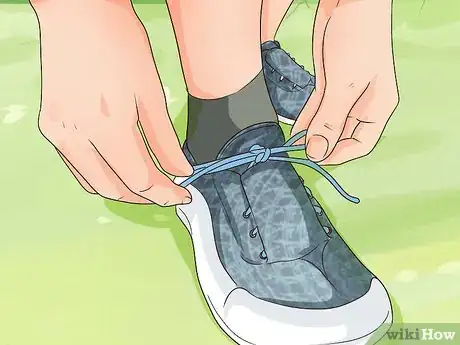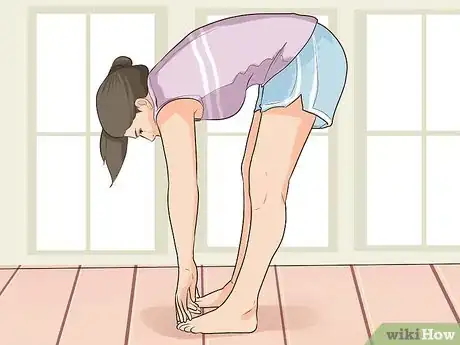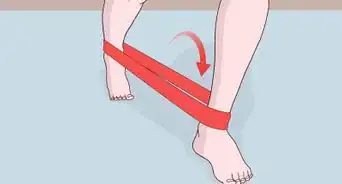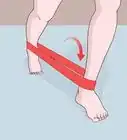This article was co-authored by Kai Ng. Kai Ng is a USATF and RRCA Certified Running Coach at Run Coach Kai. Kai has competed in over 55 races and over 15 marathons, and has trained with 16x USA and World record holder Patti Catalano Dillonso. He specializes in coaching runners of all levels and showing people that everyone can be a runner. Kai is committed to helping his clients reach their goals by showing them how to run with proper form and holding them accountable to train consistently.
There are 11 references cited in this article, which can be found at the bottom of the page.
This article has been viewed 54,425 times.
Running is one of the best exercises you do can do. It technically costs nothing and can be done anywhere. In addition, running burns more calories than most other mainstream types of exercise done for the same amount of time, like swimming[1] or walking. Running also has real health benefits beyond weight control and maintenance; it can reduce your risk of chronic illnesses, including heart disease, stroke, and diabetes, and can also keep you mentally strong and healthy.[2] There are a number of way to become a better, stronger, safer, and more efficient runner.
Steps
Gearing Up
-
1Set a goal. Think about why you are motivated to run. Are you training for a race or charity run? Have a running event to prepare for is useful in sticking your run schedule and keeping up your motivation.[3]
-
2Get a friend to run with you or join a run club. Having one person or a group of people to run with at your level can help you keep motivated, especially when you're not looking forward to your run.
- You won't want to disappoint your running partner or team by stopping or giving up, and this will give you the push you need to keep running.
- A running club can be a great alternative if you have trouble committing to regular runs. Most clubs have groups for people at different levels and set times and places to meet. You can find something that suits what you're looking for.[4]
Advertisement -
3Get fitted for running shoes at a specialty running store. The American College of Sports Medicine has shown that the best indicator of a good shoe is fit, and not style, weight, or padding. At the end of the day what matters is how the shoe fits your foot.[5]
- Don't run in the wrong shoes. You might not be able to wear the brand that works great for your friend. And if you're a beginner, don't plan to just use your old gym shoes or other shoes that you use for particular sports because you're not sure how often you'll run or whether you'll really commit to it. You need shoes that are appropriate to your foot, your alignment and to your running.[6]
-
4Track the mileage on your shoes. After 300-500 miles, it's time to get a new pair. After that much running, mid-soles can become too compressed and won't return to their usual shape in between your runs.[7] If you continue to run in the same shoes, you risk injury. Your feet, Achilles tendons, and shins are usually the first to feel the brunt of old and tired shoes, but the injury can increase and become more widespread the longer you wear shoes that are no longer supportive.[8]
-
5Get other gear that will make you excited to go for a run. Although running can technically cost you nothing as long as you have shoes, it may be worth splurging to get some new gear. Having some new things might help amp up your motivation! Get a new shirt, pair of workout pants, or fun headband or hat that you are excited to wear and try out.
-
6Plan your runs. Plan when you are going to run and put it in your agenda or calendar for the week. This will keep you committed to your runs and ensure that they won't slip your mind.
- Be sure as well to plan your route ahead of time. Use an online or print map of your area and plot out your route. This is useful for finding new and alternative routes and making adjustments for distance as well as planning for particular situations like heavy traffic, road closures or construction that may make your usual route.[9]
-
7Get the music going! British researchers have found that music helps push you to reach the finish line - and your goal - faster. Create new playlists with your favorite high-energy tracks.
Training Properly
-
1Warm up. Start each run with a light warm-up of around five minutes. Warming up helps to prevent injuries caused by sudden strain on your muscles. Keep in mind that static stretching, or stretching while you stand still, before a workout can diminish performance. Instead commit to doing active stretches where you move your limbs through a range of motion. Active stretching can enhance performance.[10]
- Your warm-up can include jogging or marching on the spot, gentle jumps, side stepping, and climbing stairs, among other exercises.[11]
-
2Do walk-run intervals if just starting out. Start walking for an amount of time (anywhere between 10 and 30 minutes) that feels comfortable to you. Once you can walk for 30 minutes without losing your breath and while still feeling good, start including running intervals. These running intervals need only be 1-2 minutes and you don't need to go very fast at first. After the 1-2 minute run, return to walking at a comfortable pace.[12]
- As you get stronger, adjust the running intervals to make them longer until you are running for a full 30 minutes without walking.
-
3Build endurance - but conservatively. Unsurprisingly, the best way to build endurance for greater distance running is to run further. But the problem is that people get highly motivated and run too far too soon into their training. Instead, you need to progress gradually.[13]
- Increase your mileage by only about 10 percent per week. Do this for three weeks and then back off for a week by 20-25%. Repeat until you can run the distance you want.[14]
-
4Alternate hard runs with longer, but slower runs. Do longer runs at a slower pace, a pace where you can hold a full conversation.[15]
-
5Pace yourself. Most people start out too fast in their runs and then slow down as they get tired. Running feels a lot easier at first than it does part way through. Don't burn yourself out before you've even really begun.[18]
- Start at an easy stride and then gradually increase your pace until you reach your desire speed.[19]
-
6Pay attention to your form. Consider your running techniques - do you hunch or pound the pavement on your heel? It can take a few weeks to correct bad habits and form but making these adjustments is worth it in the long run - you'll increase your agility and speed and decrease the risk of injuring yourself.[20]
- Run with your arms, shoulders, and jaw relaxed. Have your elbows gently bent at your side.[21]
- Keep an upright posture and maintain a tall spine. Imagine a thread pulling the top of your head up to the sky.[22]
- Aim for a stride rate of 170-180 per minute. Focus on making sure your foot lands under your center gravity instead of out in front. Doing this encourages your foot to strike the ground with its middle rather than its heel.[23] Landing on your heel slows you down and can increase injury risk since you're placing more weight on your joints.[24]
-
7Stay committed. You should try to make it out for a run at least twice a week. It's important to be consistent; you'll see improvements in your running as your body adapts to the training.[25]
- It's better to run twice a week every week than to run a bunch of times in a single week and then take a few weeks off.[26]
Challenging Yourself
-
1Try a tempo workout. A tempo run means running out of your comfort zone for some sections of our run. Once a week, run easy for about 10 minutes, then ramp up the pace (to about 80-84% effort) for the next 15 minutes.
- You can also shorten these intervals; incorporate three intervals of 5 minutes at tempo pace in a 30-minute run. Use the remaining intervals to recover at your normal pace.
- Tempo runs helps strengthen your hear for distance running.[27]
-
2Do speed bursts. The best way to get faster is to acclimatize your body to a faster pace. Higher intensity runs builds power and kickstarts the fast-twitch muscle fibers required for fast running.
- Speed work can be tough but you can also make it manageable. Go for your usual run at your normal pace. Pause and get your breath, then run fast (approximately 90% effort) for 80–100 meters (260–330 ft). Then walk or jog lightly to recover. Do this anywhere between 3 and 5 times. Remember to keep your form and technique.[28]
- Incorporate speed bursts into your runs once or twice a week to notice improvement in speed.[29]
-
3Try running on the beach or in the snow. Running on soft surfaces can require nearly double the effort of running on hard surfaces like pavement. This is a great way to get in an intense, short workout, particularly while travelling.
Strengthening Your Body
-
1Do weight and strength training. Weights are a good supplement to training because they strengthen the muscles and joints. Weight training also decreases injury risk.[30] Research shows that runners who lift weights at least three times a week are stronger runners - they can run for longer and faster.
- When lifting weights to augment your running, it's best to use a heavy weight that is enough to push your limits after 5 repetitions. Lifting lighter weights with high repetitions works to develop muscle size and endurance, but will not make you run faster. Fewer reps with heavier weight will help to develop faster, more powerful muscle contractions.[31]
- Strengthen and stretch your hip flexors. Studies have shown that doing hip-strengthening exercises can improve speed and agility. Try some basic exercises like the clamshell or sidestep. Make sure you are doing hip exercises at least 2-3 times a week.[32]
- Strengthen your hamstrings. It's important for runners to have strong and open hamstrings because fatigue in those muscles can cause injuries to your knees. Dead lifts, leg curls, and box jumps are good exercises to strengthen the back of your legs and avoid hurting your joints.
- Strengthen your buttocks. Have a strong gluteus medius can help prevent lower-body injuries. Try taking the stairs instead of elevators during your daily routines.
- Strengthen your core. The core is an area often forgotten by runners. To reduce inefficient motion while running, train and strengthen your core to provide stability. Static exercises like planks will give you the best core workout, rather than endless situps where its easy to fall into the bad habit of using momentum rather than strength.[33]
-
2Cross train. Cross-training involves doing another type of fitness activity that is not running. Cycling, swimming, skiing, using the elliptical machine are all ways to pump up your cardiovascular system without straining those muscles used in running. In fact, intense cross-training for an hour can elicit the same aerobic benefits as a run.[34]
- It's important do cross-training that involves lower-impact activity than running, which is a high impact activity. This will provide some relief to your joints on non-running days. Good activities include swimming, cycling, and rowing, among others.[35]
- There is a basic formula for cross-training: Do 60 minutes at or above 70 percent of your maximum heart rate. This will be the equivalent of a 8km run.
- Incorporate cross-training into your workout a couple of times a week (on days when you don't run).
-
3Foam roll. After exercising, massage your leg muscles with a foam roller. This post-workout exercise will increase flexibility and range of motion in the knees. Rolling will also work to break down scar tissue.
Eating Right and Getting Nutrients
-
1Take fish oil supplements. Fish oil is rich in omega-3 fatty acids, which can help decrease inflammation, boost immunity and help protect against heart disease. Fish oil capsules can be purchased from most health food stores.
-
2Eat more healthy fat. Research has shown that women runners who avoid healthy fats is the top indicator of the risk of injury. In fact, consuming healthy fats can reduce your risk of running-related injuries, such as stress fractures.[36] Snacks with healthy fat include walnuts, avocado and hard-boiled eggs.
-
3Have some caffeine! Research has shown that having caffeine is good for recovery. Ingesting caffeine along with carbohydrates after an intense run rebuilds glycogen stores 66 percent better than if you simply consumed carbohydrates alone.
-
4Drink chocolate milk. Another good recovery drink is chocolate milk because it has the right concoction of carbs, protein, and caffeine to help your muscles rebuild.
-
5Create snacks with mixed nutrients. For example, layer yogurt, berries, nuts and granola to make a parfait. While this looks like a fancy snack, it also gives your body the main nutrients key to better running: calcium, antioxidants, carbs, and protein.
-
6Replenish your body with nutrients after a hard run. After an intense run, one of your next two meals should be a protein-heavy meal, which helps your muscles rebuild and repair. Add a salad of leafy greens to give your body added nutrients and minerals.[37]
-
7Drink lots of water. Before a run, drink at least 8 ounces of water about 30 minutes before you leave. This will help prevent dehydration.
- If you plan to run longer than 10 kilometres, consider bringing a water bottle with you. Staying hydrated during long runs will keep your legs from cramping and is also especially important when it is very hot out.[38]
- Even if you're not a regular runner, be sure to drink 8-10 glasses of water throughout the day. This will replenish the fluid lost during exercise. Just make sure to spread your water out and don't drink it all at once.[39]
Expert Q&A
-
QuestionShould I sign up for a race if I just started running?
 Tyler CourvilleTyler Courville is a brand ambassador for Salomon Running. He has run in 10 ultra and mountain races across the United States and Nepal, and won the 2018 Crystal Mountain Marathon.
Tyler CourvilleTyler Courville is a brand ambassador for Salomon Running. He has run in 10 ultra and mountain races across the United States and Nepal, and won the 2018 Crystal Mountain Marathon.
Professional Runner Sure! Signing up for a race is really helpful — it consistently motivates. Even in my training today, I like having something to work towards.
Sure! Signing up for a race is really helpful — it consistently motivates. Even in my training today, I like having something to work towards. -
QuestionI am naturally a good runner without training, but now my friends train and are getting better than me. Should I train to get much better?
 Community AnswerSure, if you want to catch up with them. It could be fun to keep challenging each other to do better.
Community AnswerSure, if you want to catch up with them. It could be fun to keep challenging each other to do better. -
QuestionHow can I run faster?
 Community AnswerFollow the instructions listed in the article above.
Community AnswerFollow the instructions listed in the article above.
References
- ↑ www.shape.com/fitness/cardio/which-workout-burns-more-calories
- ↑ http://www.nhs.uk/Livewell/getting-started-guides/Pages/getting-started-running.aspx
- ↑ http://www.nhs.uk/Livewell/getting-started-guides/Pages/getting-started-running.aspx
- ↑ http://www.nhs.uk/Livewell/getting-started-guides/Pages/getting-started-running.aspx
- ↑ Kai Ng. Certified Running Coach. Expert Interview. 12 February 2021.
- ↑ http://www.self.com/flash/fitness-blog/2011/07/how-to-run-better-tips-for-beg/
- ↑ http://www.active.com/running/articles/10-tips-to-run-better-and-recover-faster
- ↑ http://www.theguardian.com/lifeandstyle/2014/jul/19/how-improve-run-five-quick-fixes
- ↑ http://www.nhs.uk/Livewell/getting-started-guides/Pages/getting-started-running.aspx
- ↑ Kai Ng. Certified Running Coach. Expert Interview. 12 February 2021.
- ↑ http://www.nhs.uk/Livewell/getting-started-guides/Pages/getting-started-running.aspx
- ↑ http://www.nhs.uk/Livewell/getting-started-guides/Pages/getting-started-running.aspx
- ↑ http://www.theguardian.com/lifeandstyle/2014/jul/19/how-improve-run-five-quick-fixes
- ↑ http://www.self.com/flash/fitness-blog/2011/07/how-to-run-better-tips-for-beg/
- ↑ http://www.theguardian.com/lifeandstyle/2014/jul/19/how-improve-run-five-quick-fixes
- ↑ Kai Ng. Certified Running Coach. Expert Interview. 12 February 2021.
- ↑ http://www.theguardian.com/lifeandstyle/2014/jul/19/how-improve-run-five-quick-fixes
- ↑ http://www.self.com/flash/fitness-blog/2011/07/how-to-run-better-tips-for-beg/
- ↑ http://www.active.com/running/articles/10-tips-to-run-better-and-recover-faster
- ↑ http://www.theguardian.com/lifeandstyle/2014/jul/19/how-improve-run-five-quick-fixes
- ↑ http://www.nhs.uk/Livewell/getting-started-guides/Pages/getting-started-running.aspx
- ↑ http://www.theguardian.com/lifeandstyle/2014/jul/19/how-improve-run-five-quick-fixes
- ↑ http://www.self.com/flash/fitness-blog/2011/07/how-to-run-better-tips-for-beg/
- ↑ http://www.theguardian.com/lifeandstyle/2014/jul/19/how-improve-run-five-quick-fixes
- ↑ Kai Ng. Certified Running Coach. Expert Interview. 12 February 2021.
- ↑ http://www.nhs.uk/Livewell/getting-started-guides/Pages/getting-started-running.aspx
- ↑ http://www.theguardian.com/lifeandstyle/2014/jul/19/how-improve-run-five-quick-fixes
- ↑ http://www.theguardian.com/lifeandstyle/2014/jul/19/how-improve-run-five-quick-fixes
- ↑ http://www.theguardian.com/lifeandstyle/2014/jul/19/how-improve-run-five-quick-fixes
- ↑ http://www.runnersworld.com/tag/strength-training
- ↑ http://breakingmuscle.com/running/weight-training-basics-for-runners
- ↑ http://www.active.com/running/articles/hip-strengthening-and-mobility-exercises-for-runners
- ↑ http://breakingmuscle.com/running/weight-training-basics-for-runners
- ↑ http://www.runnersworld.co.za/training/cross-training/cross-training-for-runners/
- ↑ http://www.runnersworld.co.za/training/cross-training/cross-training-for-runners/
- ↑ http://www.runnersworld.com/nutrition-runners/good-fats-bad-fats
- ↑ http://www.active.com/running/articles/10-tips-to-run-better-and-recover-faster
- ↑ http://www.active.com/running/articles/10-tips-to-run-better-and-recover-faster
- ↑ http://www.active.com/running/articles/10-tips-to-run-better-and-recover-faster
About This Article
Getting better at running will take time and commitment, but it will make you stronger and healthier in the long run. Stretch your leg and arm muscles to warm them up for 5 to 10 minutes before you start, which helps to reduce the chance of injury. Increase the length of your runs a little each week, which will allow you to build endurance sustainably. Pace yourself at the beginning of each run, since the easiest mistake to make is to start too quickly and run out of steam. You should also alternate between hard, short runs on some days and longer, slower runs on others. This will help rest your muscles in between your fast runs while at the same time building your stamina. If you struggle to stay motivated, try running with a friend or in a group, since competing against others helps keep you focused. Invest in some running gear, like shoes and shorts, since wearing the right clothing will make it easier for you to run more effectively. For tips from our Running co-author on how to decide when to replace your running shoes, keep reading!




















































































